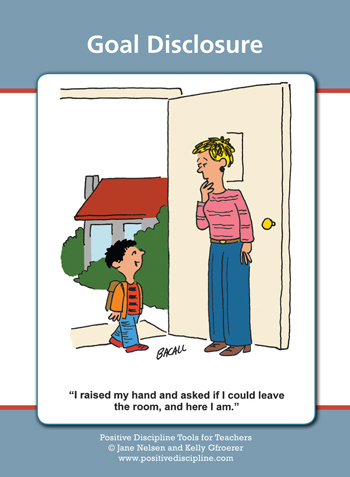by Dr. Kelly Gfroerer and Dr. Jane Nelsen
Wait for a calm time (not during conflict) to talk with a student in private. A friendly atmosphere is essential. Ask the student for permission to make guesses about why he or she is behaving in a certain way. Let the student know that he or she can tell you if you have guessed correctly or not. (This is usually an intriguing challenge to the student.) Ask the questions below, one at a time. If after any question you get a yes or a recognition reflex (for example, a spontaneous smile even while saying no—the no is an automatic denial, while the smile suggests that the student has subconsciously gained a deeper understanding of herself), you can follow up with plans for the student to get her needs met in ways that are positive and empowering. If no clarifying response to a question occurs, go on to the next question.
- “Could it be that you do this particular behavior to get my attention?” (Undue Attention)
- “Could it be that you want to show me I can’t make you do as I ask?” (Misguided Power)
- “Could it be that you feel hurt and want to hurt back?” (Revenge)
- “Could it be you believe you can’t succeed and want to be left alone?” (Assumed Inadequacy)
Here are some effective responses if the student responds with a yes (or a recognition reflex) to a question indicating a specific goal.
- Undue Attention: “Everyone wants attention. There are encouraging ways and discouraging ways to get attention. Would you be willing to work with me on a plan for you to get attention in ways that are positive and encouraging to others as well as yourself, such as a morning greeter?”
- Misguided Power: “Power can be used in encouraging ways or discouraging ways. I would appreciate your help in using your power in ways that are useful to yourself and the whole class. Would you be willing to lead our class meeting tomorrow, or would you like to be a tutor in one of the lower grades for a student who needs some help?”
- Revenge: “I can see that you are feeling hurt. I’m so sorry. Is there anything I can do to help?” When the mistaken goal is Revenge, validating hurt feelings is often enough to invite behavior change. If it doesn’t seem that validation is enough, follow up by saying, “Would you like to get together again tomorrow to see if we can figure out some ways to find a solution to this challenge?”
- Assumed Inadequacy: “I won’t give up on you. I care too much. We’ll do whatever it takes to help you succeed. Let me show you some small steps to help you get started.” (For example, if the child is having trouble drawing a circle, say, “I’ll draw the first half of the circle, and you can draw the second half.” This technique can be effective with whatever learning task the student is struggling with.)
Click Here to View the Mistaken Goal Chart.
Goal disclosure can be a powerful tool. When the teacher’s empathy is genuine, the student experiences a connection with the teacher that is deeply caring. Goal disclosure will help you better understand your student, and your student will gain valuable insights about his or her deeper needs and motivations.
A teacher’s friendly demeanor during goal disclosure demonstrates how much he or she cares. Because effective goal disclosure includes authentic empathy from the teacher and a new sense of connection for the student, the process will increase the student’s feeling of belonging and contribution. Remember, when belonging and contribution increase, misbehavior decreases.
Tool in Action from Atlanta, Georgia
After over thirty years of teaching children from different backgrounds and with different abilities, I have found that the program that works for all children in a positive, encouraging, respectful way is Positive Discipline. Positive Discipline has helped me redirect my discipline methods toward a more child-focused approach. I am more effective at helping my students find new, more appropriate behaviors, along with a sense of belonging and significance in my classroom.
The tool I use during each and every school day is the Mistaken Goal Chart. This tool has made the biggest difference in my understanding of a child’s purposeful, although at times misguided, behavior. By recognizing the child’s belief behind his behavior of choice, I have been able to redirect behavior so that positive outcomes can occur for the child, myself, and the whole class. Instead of being irritated by a child who consistently needs undue attention, I now see the purpose behind his behavior and understand the child’s private logic and misguided goal.
Instead of reacting out of my own stress when I feel irritated, I become a goal detective and look for the coded message in the child’s misbehavior. I realize the child’s behavior is his way of saying “notice me, connect with me.” I have a game plan that immediately brings into play the tools that will help the student connect in positive, constructive ways, rather than continuing to seek this connection in negative ways. I know that giving the student a job, involving the student in a cooperative learning group, and sim- ply taking a moment to check in with him individually are all ways to meet his goal in a positive way and facilitate change. Knowing there is always a goal behind a student’s behavior keeps me from simply react- ing emotionally and becoming a part of the child’s misguided behavior. Instead, I can think rationally and focus on the clues that reveal the student’s actual need as opposed to the mistaken belief that is motivating his negative behavior.
—Meg Frederick, kindergarten teacher, Atlanta


No Comments yet!